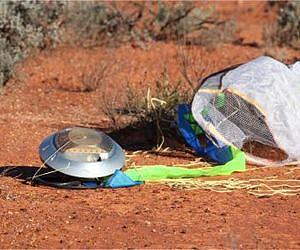
This is a Hayabusa capsule landed at Woomera in South Australia. Credit: [Image courtesy JAXA/ISIS]
Researchers got their first up-close look at dust from the surface of a small, stony asteroid after the Hayabusa spacecraft scooped some up and brought it back to Earth. Analysis of these dust particles, detailed in a special issue of the journal Science this week, confirms a long-standing suspicion: that the most common meteorites found here on Earth, known as ordinary chondrites, are born from these stony, or S-type, asteroids.
And since chondrites are among the most primitive objects in the solar system, the discovery also means that these asteroids have been recording a long and rich history of early solar system events.
The 26 August issue of Science includes six reports and a Perspective article that highlight the initial studies of this asteroid dust. Science is published by AAAS, the nonprofit science society.
The Hayabusa spacecraft was launched by the Japan Aerospace Exploration Agency (JAXA) in 2003 to sample the surface of the near-Earth asteroid known as 25143 Itokawa. The unmanned vessel reached its destination a little more than two years later-and in November 2005, it made two separate touchdowns on the surface of Itokawa.
Although its primary sampler malfunctioned, the spacecraft was able to strike the asteroid's surface with an elastic sampling horn and catch the small amount of dust particles that were kicked up. After reentering Earth's atmosphere and landing in South Australia in June 2010, Hayabusa's delicate samples were analyzed extensively by various teams of researchers.
"Science is very excited and pleased to be presenting these important scientific analyses," said Brooks Hanson, Deputy Editor of the Physical Sciences.
"The first samples that researchers collected beyond Earth were from the moon, and the first analyses of those samples were also published in Science. Those samples, along with the more recent sampling of a comet and the solar wind, have changed our understanding of the solar system and Earth. They are still yielding important results.
These Hayabusa samples are the first samples of an asteroid. Not only do they provide important information about the history of the asteroid Itokawa, but by providing the needed ground truth that is only possible through direct sampling, they also help make other important samples-like meteorite collections and the lunar samples-even more useful."
The asteroid sampled by Hayabusa is a rocky, S-type asteroid with the appearance of a rubble pile. Based on observations from the ground, researchers have believed that similar S-type asteroids, generally located in our solar system's inner and middle asteroid belt, are responsible for most of the small meteorites that regularly strike Earth.
But, the visible spectra of these asteroids have never precisely matched those of ordinary chondrites-a fact that has left researchers suspicious of their actual affiliation. The only way to confirm a direct relationship between meteorites and these S-type asteroids was to physically sample the regolith from an asteroid's surface.






No comments:
Post a Comment